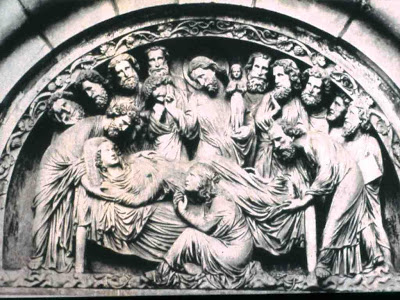Back when I
was in college I had an art history class that met at 8:00am .
I both looked forward to the class and I dreaded it: why? Because I loved looking at slides of art for
an hour and half two days a week. But I
knew how hard it was to sit in the dark and try to stay awake.
It was at
that moment that I turned my head slightly and noticed that behind us was an
enormous bas-relief carved on the outside of the cathedral. It looked very familiar (I guessed I had
managed to stay awake for that class, at least) . I said, “Yes, Christian art testifies to
Christian doctrine, it is part of tradition.
As in this exquisite 1000 year old sculpture to our right of the
Assumption of Mary.”
 |
| Assumption of Mary (Strasbourg Cathedral) |
 Does anybody
remember the movie “It Came From Outer Space!”? The movie
wasn’t all that memorable, but it was
shown in 3D, and the
movie poster promised
that in 3D Vision! this
otherwise pedestrian science fiction film would be: Amazing! Exciting! Spectacular!
Does anybody
remember the movie “It Came From Outer Space!”? The movie
wasn’t all that memorable, but it was
shown in 3D, and the
movie poster promised
that in 3D Vision! this
otherwise pedestrian science fiction film would be: Amazing! Exciting! Spectacular! 3D movies, (which have made a comeback in a big way recently) were a shortlived fad during the 1950’s . What made the film appear 3D were the cardboard glasses (issued to each paying customer) which enabled them to see the film in three-dimensions.
What, you
might ask, do 3D movies
and those goofy 3D glasses have in
common with the feast of the Assumption which we are
celebrating today? This: to fully understand
today's scripture readings in relation
to today’s feast, we need our
own 3D glasses to bring out
dimensions of the
sacred text that might
otherwise escape our notice.
and will accomplish in the Church in its pilgrimage of faith and what God has accomplished and will accomplish in the lives of each one of us.
On this
feast day, we affirm
and celebrate this Christian mystery: that after
her death,
Mary entered
body and spirit into the
resurrected life of her Son. We believe
that the one who by God’s grace and favor was the
Theotokers, the Godbearer, who bore God
in the flesh into this world, was herself,
in the flesh, by God’s
grace and favor, borne by God
into the life of the world to come.
If things
simply ended there, as a special
privilege afforded by Jesus to
his Mother,
then the
Assumption would not merit that much
attention. But we
celebrate this feast as a major holy day, a holy day
of obligation, in fact, precisely
because what happened to Maryis significant, not only for herself but is significant for the Church
and for every disciple.
death, which has been destroyed. All who belong to him, beginning with Mary,
share in the resurrection of Jesus.
With the
resurrection of Jesus God’s temple
in heaven opened and with the
assumption of Mary we can see
with the eyes of faith, Mary, the
living ark of the covenant in the
special place prepared for her by God,
Mary is a
sign for all of us, all of us who
have already entered the living
temple of the Church washed clean
by baptism,anointed
with the Holy Spirit, bearing
Christ within us
each time we
eat his Body and drink his Blood. Mary’s
assumption is a sign to usof God’s faithful love which has overcome sin and death.
 from the
waters of baptism as adopted
sons and daughters of the Father. We will be
raisedup, as Mary was, with all who
belong to God.
from the
waters of baptism as adopted
sons and daughters of the Father. We will be
raisedup, as Mary was, with all who
belong to God. On the feast of the Assumption, which is in the late summer, just as the harvest
in the northern hemisphere is beginning to come in, we celebrate the rich harvest
of Christ’s resurrection actualized in Mary, in the Church, his Body, and in all of the baptized.
On this
feast of the Assumption, let us, like
Mary, praise and thank with joy, our faithful
God, who has done
such great things, for Mary and
for all who belong to him.
.jpg)
















